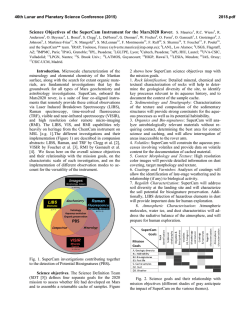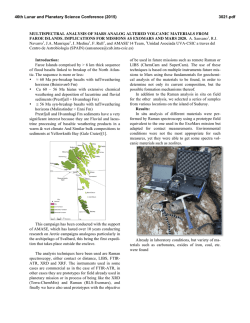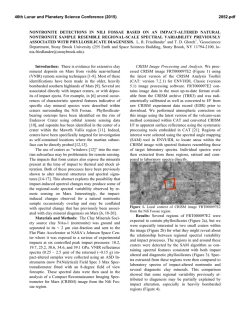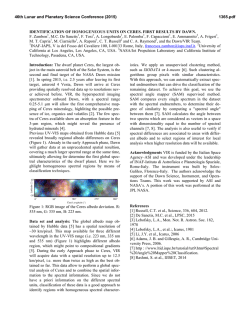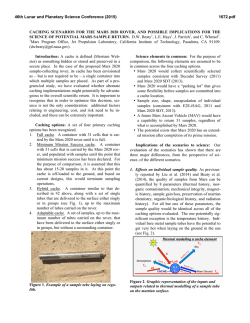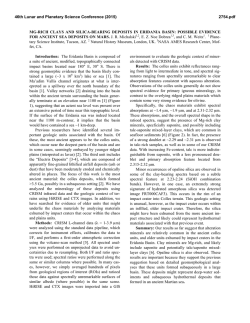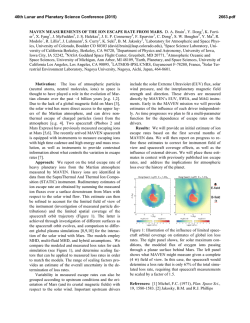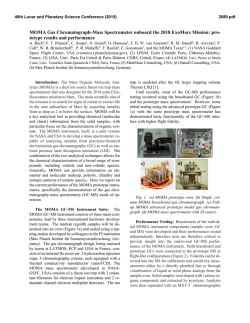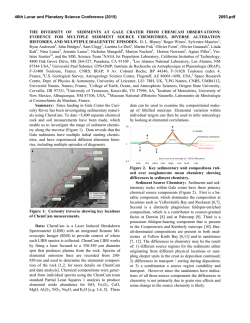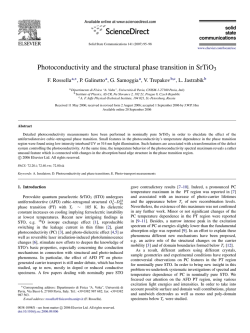
1736
46th Lunar and Planetary Science Conference (2015) 1736.pdf The Infrared Investigation on the SuperCam Instrument for the Mars2020 Rover. T. Fouchet1, F. Montmes2 3 3 4 5 1 6 7 sin , O. Forni , S. Maurice , R.C. Wiens , J.R. Johnson , S.M. Clegg , P. Beck , F. Poulet , O. Gasnault3, P.-Y. Mes1 2 3 lin , and the SuperCam Team. Observatoire de Paris, LESIA, Meudon ([email protected]); LATMOS, 3 4 5 6 7 Paris; IRAP, Toulouse; LANL; APL/JHU; IPAG, Grenoble; IAS, Orsay. Introduction: The Mars2020 Science Definition The Mars2020 rover will bring down this spatial resoTeam (SDT) has highlighted the need for both context lution to 1.3 mm at 2 m distance from the rover to and fine-scale mineralogy to address the Mission Scicompletely identify the mineralogy of outcrops, and to ence Objectives A and B of deciphering the geological determine the occurrence and distribution of various processes and history of an astrobiologicaly relevant minerals within the scene. In synergy with context ancient environment on Mars, and assessing the biimaging, this will allow to better understand the forosignature preservation potential of this environment. mation and alteration of the landing site, and particiThe SDT particularly emphasized the need for this pate to the selection of potential biominerals and l SuperCam mineralogy measurement to be nested and co-aligned cached samples. Moreover, SuperCam LIBS will parwith context imaging and fine-scale elemental chemistially clear away dust coatings on surfaces within the ely long integration time. The pulsed laser approach makes the resulting spectra far try. IR FOV to maximize the infrared spectroscopy identio high fluorescence and ambient light backgrounds. SuperCam on Mars 2020 is a suite of four instrufication power. Cam’s Raman instrument will also detect and identify organic materials by their ments that provide these critical observations via Laser Scientific requirements: fluorescence spectra over 534-900 nm (e.g., [69,70]). Organic and biological Induced Breakdown Spectroscopy (LIBS), Raman Wavelength range. The LIBS laser operates at 1064 oduce fluorescence both with UV and visible laser excitation with very short spectroscopy [1], visible and near-infrared spectrosconm on SuperCam, capitalizing on ChemCam’s high 1 ns to 200 ns; e.g., [70-74]). Our time-resolved instrument will be able to (VISIR), andfrom high resolution color imaging, all co-minerals heritage telescope design rejecting the laser light. By ort-lived organicpyfluorescence that of longer-lived (µs-ms) and rocks aligned and at micro-radian angular resolution. Here operating s identifying targets that have biological molecules embedded in them. In the theinstrument in passive mode (no laser) we describe the scientific objectives, the technical imthis will allow ological materials, SuperCam Raman will not have interference from short-lived collection of data in the ~0.4-0.9 µm wavelength range to assist in the identification of ironbackgrounds. plementation and performances of the SuperCam infrared investigation. bearing minerals [12]. le and Infrared Spectroscopy Scientific Rationale: Orbital inFig.1 Mineral signatures within spectroscopy tofrared ~2.6spectroscopy µm has demonstrated its has completely the SuperCam IR range. Data from pability in the revolutionized detection andouridentification of concept of the CRISM [13]. ses through characteristic absorption features Martian history and particularly The SuperCam IR spectrometer ectronic processes, vibrational and/or demonstrated thestretching presence in the has been designed to work in the aracteristic molecular bounds (e.g., [75-77]). The past of persistent liquid water at or 1.3-2.6 µm wavelength range to wavelength range µm, 1.3–2.6 near(0.3–0.9 the surface of the planet. µm) Inidentify the following minerals : i) identification ofdeed, mostthe minerals to be found in the two infrared instruments, Ortho- and chain silicates through cal record [78] (Fig. D.2.1.3-1): OMEGA on board the Mars Express Fe-related crystal field bands nd hydroxides characterized by a large absorption spacecraft, and CRISM on board the around 1.0 and 2.0 µm, the latter ge transfer extending from the ultraviolet to NIR MRO spacecraft have definitively discriminating pyroxene from oliow features of identified Fe3+ transitions (0.65/0.85 µm) phyllosilicates [2,3], sulvine; ii) hydrated silicates (mostly hemCam passive spectra [4]; fates [4,5], carbonates [6], and zeoand chain silicates through Fe2+ transitions that phyllosilicates), through the first lites [7,8]. Orbital infrared spectrose absorption bands around 1.0 and 2.0 µm, the harmonics of the fundamental vibracopy has also its been very successful nates pyroxene from olivine; position strongly tional mode of hydroxyl radical OH in identifying various[79,80]; igneous mine crystal chemistry of the pyroxene (1.4 µm) and through the transverse erals [9], mostly within mafic icates (phyllosilicates, smectite), through therocks first vibrational modes of Al-OH (2.2 with low silica mode contents, but also the fundamental vibrational of hydroxyl µm), Mg/Fe-OH (2.28-2.35 µm) and some rare of anorthosites 1.4 µm) and through theexamples transverse vibrational SiOH (2.20-2.5 µm) ; iii) sulfates Infrared is also OH (2.2 µm) and[10]. Mg-OH (2.3 spectroscopy µm), [81,82]; (mono- and polyhydrated) through very sensitive to organics, even if (mono- and polyhydrated) through combinations combinations and overtones of OH– none have been detected so far on es of OH– or H2O bending and stretching or H2O bending and stretching funthe and surface Mars this tech(1.4 µm, 1.9 µm) 3ν3of (SO overtone (2.4 4)2–using damentals (1.4 µm, 1.9 µm) and nique. Finally, atmospheric dust, 3ν3(SO4)2–overtone (2.4 µm) ; iv) Fig. D.2.1.3-1. Mars mineral CO2 andand H2Ocombinations clouds can be of efficiently tes through overtones C-O detected and carbonates through overtones and combinations of C-O signatures over the SuperCam monitored [11]. d bending vibrations (3ν3 atatinfrared 2.3 µmwavelengths and (ν1 +2ν 3) stretching and bending vibrations (3ν3 at 2.3 µm and IR range;thedata from CRISM have globally The wavelengths ofOrbital their instruments minima identify majorcharacterized (νalso [78]. SuperCam 1 +2νcovers 3) at 2.5 µm), v) complex organic compounds ydrous carbonatesmineralogy with mostly Mg exhibit minima of the Martian surface, but have been limfrom absorptions at 1.7 and 2.3-2.5 µm due to various the 0.4-0.9 µm range. velengths than those with mostly and Fe to [87]. ited in their spatialCa resolution > 20 meters per pixel. dition, VISIR spectroscopy might provide a tool to identify complex organic om absorptions at 1.7 and 2.3-2.5 µm due to various combinations of CH2 and CH3 nd symmetric stretch [88]. Cam records atmospheric CO2, CO, H2O, O2 (IR and 700-850 nm) and O3 (UV). tral range is used to measure scattered light diagnostic of aerosol size distribution, and opacity. These measurements will be made by fitting the observed sky radiance 46th Lunar and Planetary Science Conference (2015) combinations of CH2 and CH3 asymmetric and symsymmetric stretch. Spectral resolution and signal-to-noise ratio. These two requirements are closely intertwined in the need to fully resolve the absorption bands and determine accurately their center position to discriminate the structure of various minerals. Following [14], we chose to set a constant 30 cm-1 FWHM within the full spectral range (i.e. 5 nm at 1.3 µm, 10 nm at 1.82 µm, and 20 nm at 2.6 µm), while achieving a SNR of 100:1 for a solar zenith angle of 30° at Mars aphelion on 0.3 lambertian albedo in 150 ms of integration per spectral element. Spatial resolution: To capitalize on the ChemCam heritage, the telescope and the optical fiber design will remain identical in SuperCam. This design sets an angular FOV of 0.67 mrad for the IR spectrometer, translating to a spatial FOV of 6.7 cm at 10 meters, within the SDT requirements for context mineralogy and 1.3 mm at 2 meters, close to the 0.5 mm SDT requirement for fine scale mineralogy. Calibration Accuracy: The IR spectrometer must account for time-dependent, wavelength-dependent variations in solar illumination as it is filtered by atmospheric aerosols and gases. To prevent artifacts from this variable environment to affect the mineralogical identification enabled by the high SNR, a calibration target mounted on the deck of the rover will realize a relative calibration accuracy of 1% in radiance. Investigation design: The SuperCam IR spectrometer is based on the SPICAM-IR spectrometer on Mars Express [15]. It is an independent device, linked to the telescope objective by a 300 µm core fiber (length < 20 cm, ChemCam connectors, multi-mode fiber, 0.12 numerical aperture). This optical fiber link requires the IR spectrometer to be mounted on the Mast Unit to maximize the transmission. A radio-frequency (RF) signal drives a transducer, which is attached to the side of an Acousto-Optical Tunable Filter (AOTF). Thus, for each frequency of the piezo, a single wavelength is selected and scattered by ±4° (2 polarizations). The main beam is rejected, while both polarizations are registered by two HgCdTe (MCT) photodiodes and summed (Fig. 2). These MCTs are packaged with a triple-stage TEC. The spectrometer is mounted directly on the SuperCam Optical Box to passively minimize its temperature. The detector TEC can lower the photodiode temperature up to 70°C below that of the spectrometer (verified in the laboratory), although a smaller delta is required usually. The RF driver is designed to independently address 256 wavelengths equally spaced at 15 cm-1 to achieve the Nyquist sampling of the AOTF 30-cm-1 spectral window. Design du spectro IR 1736.pdf Thermal strap to thermal I/F RF driver Detector front-end electronics Fig.2 IR spectrometer optical path Considering the heritage and the simplicity of the 17 design, the IR spectrometer provides extremely valuable science, especially at far distances, using minimal resources (mass of 600 g and volume of 140×56×45 mm3, see Fig. 3). Fig. 3: Mechanical design of IR spectrometer The spectral scanning flexibility of the SuperCam IR spectrometer will allow various operation modes. The scan mode will perform 30° exploration in azimuth of limited spectral bands to explore the mineralogical diversity of the scene, while raster and fine scale modes will explore the full spectral range of specific targets. References: [1] Clegg S.M. et al (2015), this meeting. [2] Poulet F. et al. 2005. Nature 438, 623. [3] Mustard J.F. et al. (2008) Nature 454, 309. [4] Gendrin A. et al. (2005). Science 307, 1587. [5] Carter J. (2013) JGR 118, 831. [6] Ehlmann B.L. et al. (2008) Science 322, 1828. [7] Ehlmann B.L. et al. (2009) JGR 114, E00D08. [8] Loizeau D. et al. (2012) Icarus 219, 476. [9] Mustard J.F. et al. (2005). Science 307, 1594. [10] Carter J. and Poulet F. (2013). Nature Geoscience 6, 1008. [11] Wolff M. et al. (2015) in The Atmosphere and Climate of Mars. Cambridge University Press. [12] Johnson J.R. et al. (2015) Icarus, http://dx.doi.org/10.1016/j.icarus.2014.02.028. [13] Ehlmann B.L. and Edwards, C. (2014) AREPS 42, 291. [14] Swayze G.A. et al (2003) JGR 108, 5105. [15] Bertaux J.-L. et al. (2000) PSS 48, 1303.
© Copyright 2024
